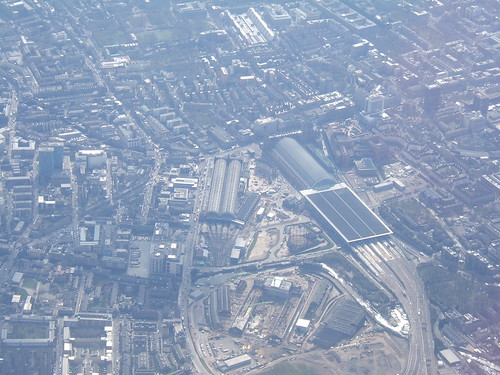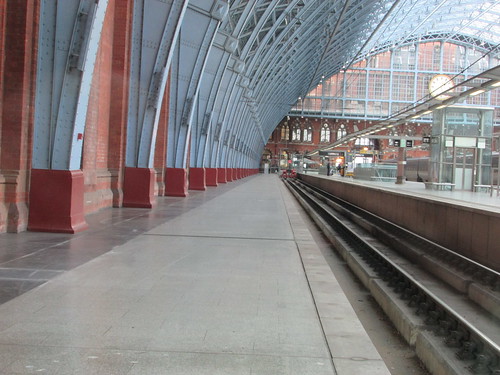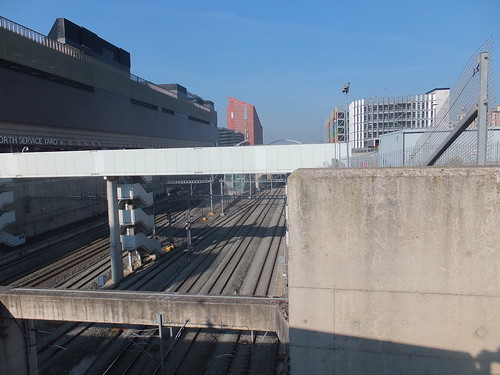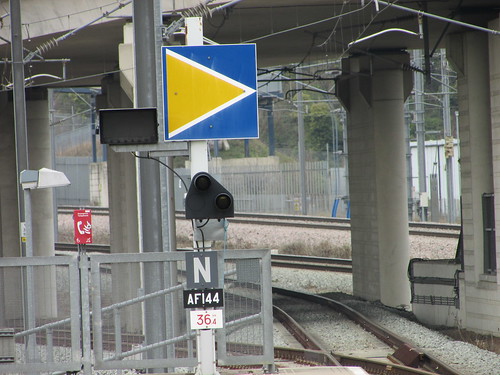
London: Aerial view looking south in 2009 showing King's Cross (left) and St. Pancras International (right).
St. Pancras International
The Grade 1 listed station hotel in Gothic Revival style fronting Euston Road was designed by George Gilbert Scott (see Wikipedia article here) and has been handsomely restored. I'm glad it's been saved but even I find its exuberant style a bit florid.

London: St. Pancras International: restored frontage to Euston Road.
I passed through the entrance onto the station concourse beneath the magnificent arched roof designed by William Henry Barlow (see Wikipedia article here). This has also been restored and I commented approvingly in a 2008 post here. The concourse area was eerily quiet on my visit, as were the international platforms, segregated behind their glass walls.

St. Pancras International: View of Barlow's trainshed looking south, with International Platform 10 on the right.
But looking down to the undercroft below, I could see plenty of activity. The need for the Midland Railway approaching St. Pancras to cross over the Regent's Canal just north of the station required the platforms to be elevated above the level of Euston Road. Barlow turned this necessity into a virtue by building the undercroft to store the major shipments of beer from Burton-on-Trent required to slake the Capital's thirst! Now, the undercroft presents shopping and eating opportunities to the traveller. The modified undercroft and the new-build concourse at ground level just north of the original train shed were much busier. This concourse has ticketing and check-in for international services on the south side, domestic ticketing on the north side and exits to the adjacent King's Cross Station of the east side.
I successfully purchased a return to Ebbsfleet International from an automatic machine and took the escalator to platform level to catch the 11:12 Southeastern High-speed domestic service, operated by a Class 395 'Javelin' Electric Multiple Unit (EMU). The Class 395 can run at up to 140 m.p.h. on High Speed 1. Back in 2007 I was involved in design and testing for some of the on-board signalling equipment for this design. There's a short post about the design here and a post about site testing here.

London: St. Pancras International: High-Speed Domestic Platforms.
High Speed 1
High Speed 1, linking the Channel Tunnel (opened 1993) to London, was built in two stages. The first stage, opened in 2003, allowed high speed running at up to 186 m.p.h. between the Channel Tunnel and the vicinity of Ashford International; Eurostar trains then continued to Waterloo International station in London on existing, third-rail d.c. electrified lines. In 2007 the northern section was completed to Stratford and St. Pancras, providing maximum speeds of 140 m.p.h., and a new maintenance depot at Temple Mills replaced the original one at North Pole. The Wikipedia article here briefly outlines the 'alarums and excursions' involved during the completion of this very expensive project.
My Class 395 departed on time with the train reasonably full. Leaving St. Pancras, colour light signals are provided and the KVB control system. 'KVB' stands for 'Contrôle Vitesse par Balise' ('Speed Control by Beacon') since the system is of French origin. The track layout is quite interesting. CTRL curves to the right, but throws off three connections on the left: a maintenance siding which connects with the Midland Mainline, the single line Silo Curve which joins the North London Line at Camden Road (allowing running onto the West Coast Main Line) and the single line ECML Connection. There's also a North London Line CTRL Connection from York Way South Junction to join Silo Curve at Cedar Junction. The picture below was taken from a CTRL train arriving at St. Pancras International.

Approaching St. Pancras International on Up CTRL (on viaduct)). Down CTRL in foreground, ECML Connection behind. Silo Curve left rear and North London Line CTRL connection right rear converge at Cedar Junction in the distance.
The ECML Connection (currently not in regular use) joins the much older North London Incline at York Way North Junction, then joining the Down Slow of the East Coast Main Line just south of the Copenhagen Tunnels. Leaving St. Pancras International, I just managed to picture the East Coast Main Line and Copenhagen Tunnels before the double-track CTRL crossed the East Coast Main Line on a covered bridge.

London: Leaving St. Pancras International on CTRL, North London Incline and ECML Connection on left, high level bridges of North London Lines crossing the East Coast Main Line on right with south portals of Copenhagen Tunnels in the distance. The portal of the covered bridge on HS1 is just visible on the right.
We entered the twin tunnels called London Tunnel 1, each around 7.5 km long. In-cab signalling using the TVM-430 system is in use. This system is also French and 'TVM' stands for 'Transmission Voie-Machine' ('Track to Train Transmission). There's a useful article on Wikipedia here. Left-hand running is normally adopted but the signalling is arranged to allow bi-directional running when required.
At Stratford International, the London 1 tunnels emerge into a long concrete station box, open to the sky but not very attractive. There's plenty of pointwork and a single line grade-separated connection allows empty stock to get to and from the depot at Temple Mills. From north to south, the six lines of High Speed 1 are Down International, Down CTRL, Down RDO, Up RDO, Up CTRL, Up International. My train paused at the single island platform used by Southeastern trains. The Down CTRL and Up CTRL are through lines used by Eurostar services whilst the Down International and Up International loops are flanked by platforms although these are currently unused.

High Speed One: East end of Stratford International. Looking west towards St. Pancras from Montifichet Road with the Westfield Stratford City on left.
My train continued through the twin tunnels called London Tunnel 2, each just over 10 km long, emerging at Dagenham Docks Junctions, where connections allow freight trains from the Channel Tunnel to reach Ripple Lane Railhead. The Tibury branch of the line from Fenchurch Street ran parallel past Rainham to our north, then we crossed over that line near Purfleet, with views of the River Thames and the disused Littlebrook Power Station on the south bank. After brief views of the Queen Elizabeth II Bridge which (together with a twin-tube tunnel) carries the M25 motorway across the river, we made our own river crossing by the twin tubes of the Thames Tunnel which, including covered ways extending beyond the tunnel portals, are a little over 3 km long.

View from High Speed 1, looking across the River Thames, with the Queen Elizabeth II Bridge on the left.
Ebbsfleet International
Emerging from the Thames Tunnel, we were already slowing for Ebbsfleet International. Like Stratford International, there are six lines through the main station, but arranged in a different order. From east to west they are Down CTRL, Down International (with platform), Down Domestic LL and Up Domestic LL (both served by an island platform), Up International (with platform) and Up CTRL. The Domestic Platforms are identified as 'LL' for Low Level as there is a further island platform for Domestic High Speed trains continuing on the (conventional) North Kent Line. High speed domestic services from St. Pancras International for the North Kent Line diverge via a grade-separated junction just after the Thames Tunnel and, after stopping at the High Level platform, join the North Kent Line from Dartford at Springhead Junction, another flyover junction.
I left the train which continued to Margate and set about a brief survey. The station is surrounded by grassland with several large car parks. There were taxis and people waiting for a bus. Swanscombe lies to the West with Dartford further afield. Northfleet lies to the east with Gravesend a little more remote.

High Speed 1: Ebbsfleet International. Looking towards the coast as the train I arrived on leaves, viewed from Down Domestic Platform with the Down International Platform on the left.
The station really is 'International' (unlike Stratford) and two continental departures were on the information display near the Eurostar Check-In.

High Speed 1: Ebbsfleet International, Passenger Information Display at 'Eurostar' Check-In.
I then travelled back to St. Pancras International on another Class 395, after an informative few hours learning about CTRL and I made my way to a very enjoyable Afternoon Tea.

High Speed 1: Ebbsfleet International. Looking towards St. Pancras from Down Domestic Platform with the TVM Block Marker and subsidiary signal AF144.
Books
Track diagrams of the Channel Tunnel Rail Link are in the following publication (or later issue):-
‘Railway Track Diagrams Book 5: Southern and TfL’ (TRACKmaps: 3rd edition) ISBN 978-0-9549866-4-3
Related sites
St Pancras railway station (Wikipedia).
High Speed 1 (Wikipedia).
Transmission Voie-Machine (Wikipedia).
HS1 Ltd (The operating company).
St. Pancras International.
Stratford International.
Ebbsfleet International.
Ashford International.
Related posts on this site
Class 373 Test Train to Grantham.
London's Terminal Stations (discusses St. Pancras).
Crewe International Electric Maintenance Depot.
Class 395 Trainsets.
Testing Class 395 Trainsets.
My Pictures
Where necessary, clicking on an image above will display an 'uncropped' view or, alternately, pictures from may be selected, viewed or downloaded, in various sizes, from the albums listed:-
London: St. Pancras Station.
High Speed 1.
Class 395: Testing.
Channel Tunnel and High Speed One.
London, England.
